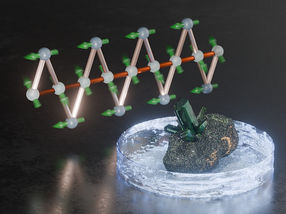Birth of photo-sensitive magnets
New functional photonic materials and devices based on magnetism
Members of the spin-photonics team at Tokyo Tech including KosukeYamamoto, a master's course graduate student at the School of Interdisciplinary Science and Engineering, Yoshitaka Kitamoto, professor at the same school, and Hiro Munekata, professor at the Imaging Science and Engineering Laboratory (ISEL) and the leader of the team, have found through the study of photo-excited precession of magnetization using ultrashort (10-13 sec) weak laser pulses of 1μJ/cm2 or less, that spins in ultra-thin Co/Pd multi-layer films are very susceptible to light; namely, a material that could be a candidate for photo-sensitive magnets.
These findings were followed by the demonstration of polarization modulation of light signals in an optical waveguide with the same class of magnets, where this work was carried out by Kazuhiro Nishibayashi, a lecturer at ISEL and member of spin-photonic team, in collaboration with Hitoki Yoneda, professor at the University of Electro-Communications, and Atsushi Kuga, at the researcher of Science and Technology Research Laboratories, Japan Broadcasting Corporation. In this work, Nishibayashi has emphasized the feasibility of the multiplexed transmission of polarization-modulated signals, controlled ultimately by photo-excitation of a class of light-sensitive magnetic layers.
Munekata and Kitamoto started their work by discussing a class of materials in which interaction between electron orbitals and spin is strong, they decided to focus on the interface of Co and Pd, where the spin states are strongly sensitive to the slight charge imbalance at the Co/Pd interface. Illumination with a femto-second laser pulse in the ultra-short time regime, enabled them to successfully modulate the charge imbalance and vary the direction of spin ordering instantaneously. This has given rise to clear observations of oscillatory signals due to precession of ordered spins.
It is very common to use a light beam propagating in free space for studying the interactions between light and matter. In an optical waveguide, however, light propagates through strong and weak propagation channels-so called mode-propagation of light- as a consequence of interference induced by light partially reflected at sidewalls of the waveguide. Therefore, it is not straight forward to engineer the interaction between light and spins with light propagating through an optical waveguide. Experimental results obtained by Nishibayashi and colleagues show that specific points of spin in a magnetic film interact with selected modes of light, which is one of the unique points found in a magnet-waveguide system.
Inducement of periodic motion of magnetization (ordered spins) with weak laser pulses would enable us to control the polarization plane and group velocity of optical digital signals which propagate in the vicinity of magnetization. Not only multiplexing/de-multiplexing, but various applications such as optical memory (random access type) and signal delay lines (buffer memory), may also be developed by combining photo-sensitive magnetic layers and optical waveguides.
Original publication

Get the analytics and lab tech industry in your inbox
By submitting this form you agree that LUMITOS AG will send you the newsletter(s) selected above by email. Your data will not be passed on to third parties. Your data will be stored and processed in accordance with our data protection regulations. LUMITOS may contact you by email for the purpose of advertising or market and opinion surveys. You can revoke your consent at any time without giving reasons to LUMITOS AG, Ernst-Augustin-Str. 2, 12489 Berlin, Germany or by e-mail at revoke@lumitos.com with effect for the future. In addition, each email contains a link to unsubscribe from the corresponding newsletter.






















































